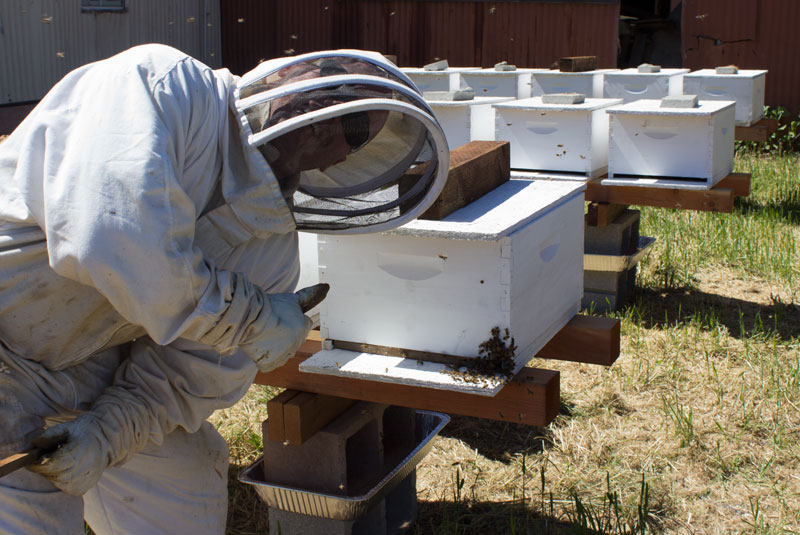Thanks for joining us for another blog post on DC-Bees.com! It has been a little while since I’ve posted, probably because I’ve been enjoying the honey mead that I made a while back! For the last several weeks I’ve been eagerly preparing a new apiary for an influx of packaged bees. This was my first use of packaged bees. I started out beekeeping by purchasing a nuc hive. I have traditionally grown my hives through raising my own queens, making splits, or purchasing a queen, if I found myself in a pickle or wanted to try a new strain of bees. This year I decided to significantly ramp up the number of hives I have, so I’m giving packaged bees a try!
So – what are packaged bees? Packaged bees are just what they sound like. A package of bees is typically a screened box containing 3 lbs. of bees. Inside the package there is an enclosed queen bee in a queen cage. There is also a can of sugar-water that is used to feed the bees during the time they are enclosed in the package. This keeps them fed while waiting to be installed into their new home. A package of bees is essentially your bare bones starter kit for beekeeping.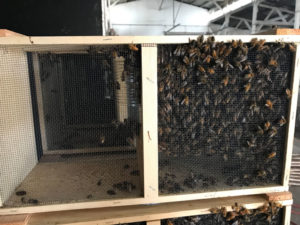
Packaged bees are often made by large-scale beekeeping operations in the spring, just after almond pollination season is over (in California anyway). The hives, fresh off of growth from pollinating and collecting nectar from almond blossoms, are primed to swarm. To keep this from happening, and to of course make money, the beekeepers will shake out a large portion of the bees from a hive, or multiple hives, into a “package” to sell. They will (hopefully!) separate out the queen bee of the original hive and introduce a new queen into the package. This queen will be safely enclosed in the queen cage. This is done because the bees would otherwise kill off any new queen introduced to the colony. The queen that is added should be a newly mated queen.
What happens when bees are shaken together is that once the bees realize they are S.O.L. and they are without a queen, they will gradually accept the new one offered to them. This occurs over a period of days as the bees become attuned to the new queen’s scent and the realization that the prior queen is gone. This is a key point. If you buy a package of bees without knowing when they were “shaken-in” together, and “how old they are” you might let loose a queen too early and the bees will not accept her, killing her off.
As I think about that, a comparison can be made with Oakland Raiders’ fans right now. Their team up and left them for Las Vegas and they are now locally S.O.L. If you are a 49ers fan, don’t gloat, (ok, do gloat – it is fun to watch), and think you can invite an ex-Raiders fan to a SF 49er’s game straight away. That will likely be answered with violent rebuke. However, give it a bit of time. I bet you more than a few will find themselves willingly sitting in Levi’s stadium before too long.
I found a good video of the process, no not of Oakland Raiders fans becoming 49ers fans, which is too disturbing to watch, this is a video of how they make packaged bees.
I digress; If you just checked out the video, or will later, you can see that putting together packaged bees is quite the process! I picked up my bees from CF Koehnen and Sons. I’ve used them in the past and have been happy with the results. I went with Carniolan Queen Packages, although I do have Italian Queen hives as well. As with any choice, there are pros and cons to selecting the type of queen bee, and therefore your hives, but we will save that topic for another day. My particular bees were “shaken” together as you saw on the video roughly two days prior to my picking them up. So, the bees have had a decent amount of time with their new queen to get accustomed to her and for them to come to realize their old queen is nowhere to be found. However, they likely aren’t fully onboard with the new queen and might be a little sentimental for the old chick. With that in mind, I still wanted to give them a day or more to get further settled prior to releasing the queen from the queen cage.
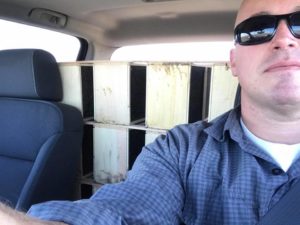
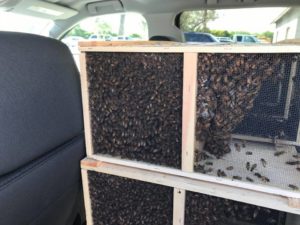
My transporting of the packaged bees home from CF Koehnen and Sons turned out a little more interesting than I expected. I elected to transport the packaged bees in the cab of my truck vs. the back so that the bees were not harmed by highway speed winds (no truck cap). If you are new to beekeeping, this is actually very normal and no, I’m not completely insane. I knew there would be more than a few bees hanging on the outside of the boxes and they would eventually fly around the inside of the cab with me as I drove home, so I covered the packages with a sheet to try and keep that to a minimum. What I didn’t plan on was that a few of the wooden boxes they were packaged in were cracked and MANY MANY bees decided to get out and ride shotgun with me. So, if you were driving I-5 South in California on April 15th, and you thought you saw a crazy person driving with a bunch of bees in his truck, you did…I got a good laugh at the cars that pulled up beside me more than twice confirming that they saw what they thought they might have imagined. Of course, my laughing and smiling back at them probably did not lessen their believe that I was a crazy person…
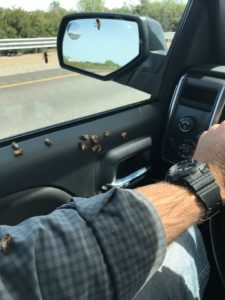
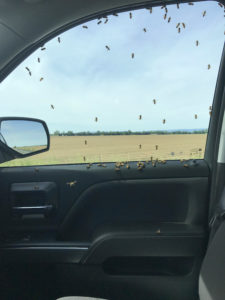
I took a few breaks driving back and let them fly out the windows. However, I didn’t think they would be aggressive or an issue, and they weren’t. Bees are very docile once they realize they have no hive to protect. So, if you find yourself in a similar situation, don’t go careening off the road in a hot panic, just KEEP CALM AND DRIVE ON. Crack your windows so the extra stragglers blow out but don’t go ping ponging into your face as you drive. Luckily, the vast majority of the bees did not leave the cracked packages. If they had been in the back of the truck, the wind would have assuredly blown them out, in addition to harming the bees.
When you do get home to install your bees, as you can see in the video, depending on how long you want the queen “trapped” in the cage, you can decide on a few release methods. I knew I needed to go to my “day job” so I wasn’t going to return to release each queen individually by hand in a reasonable time. Hand release also runs the risk of the queen getting spooked and flying away. So, here’s what you can do…
Each queen cage will have a hole in the end, plugged with cork or some other material. You can remove the cork and then plug the hole with an edible candy so that the queen can’t get out right away. I used marshmallows, which the bees would readily eat through in a short amount of time, perhaps a day. If you needed a longer time prior to release, you can make mixes of powdered sugar and water to an appropriate consistency so that the bees will more slowly eat through the material, prior to releasing the queen. However, if you do it wrong, your queen will be stuck in there and you will have to eventually get her out. Regardless, the bees will begin feeding her through her screened cage as they bond with her and begin to take care of her. Queens are a bit high maintenance, but I would be too if I had to lay 1000-2000 eggs a day.
Once the queen is released after approximately 3-6 days of being with the packaged bees, she should settle in and begin laying eggs. This will happen in just a couple of days after release if she has somewhere to lay them. If you are starting a hive from scratch, with no frames of wax comb built, the bees will need to build the wax comb prior to her laying eggs. This will take considerable energy and time, so it is important that you feed a newly installed package with both sugar water and protein. If you don’t give your newly installed hive some basic essentials, it is very possible that your hive will either starve out, die off, or fly away in the hopes of greener pastures. The time it takes the queen to begin laying is pretty crucial. Check out the picture of the honeybee life cycle – from westernbeekeepers.com.

As you can see from the image, the first eggs that the queen lays will not begin to forage for food for approximately 43 days or so. The challenge is that honeybees typically live only 5-6 weeks, but as little as 30 days in the summer when they are working the hardest (they literally work themselves to death). So, if you don’t get the queen started laying eggs quickly, the hive is going to fail. This is because all of the originally packaged bees are going to begin dying off before the newly hatched bees have a chance to kick into gear. This is why packaged bees might not always bee the best choice for beginning beekeepers, vs. a “nuc of bees”. If after installing your package of bees, you can’t find new eggs laid by the queen prior to two weeks, it is time to panic.
In the hopes of getting my hives jump started, I saved crystallized frames of honey and pollen frames from my prior season, knowing that I was looking to try packaged bees this year. I inserted several frames of honey and pollen into each hive so that they would have a great start. Hopefully, that increases the odds of the package surviving, which is nowhere near a guarantee.
After I installed the bees, I checked back on them a few days later. At that point, the queen would have been with the bees for a total of 4 days since she the hive was originally “shaken” together. I found that I had great results. I removed all of the queen cages and found that the marshmallow had been licked clean and the queen had left the cage in all but one case. In that instance, she was able to leave, so I don’t know if I just happened to find her wandering back inside the cage or if she had cold feet and never came out. Either way, I let her out and she seemed to be accepted fine by the hive. So on first look, it was a great initial success with no queens flying away or getting killed off at the onset! For each hive that I attempted to find the queen, I easily spotted her looking healthy, fat and ready to go (these are already marked and mated queens).
Be sure to check back in for an update on these newly installed packaged bees. I’ll be poking my nose in them again real soon. I need to make sure that the queen has started laying eggs in a timely fashion, or I’ll otherwise have to take steps to try and save the hive!
Hopefully, this post increased your interest in the honeybee or helped push you over the edge in getting started in the enjoyable and rewarding hobby of beekeeping. Please be sure to like and share our page so that others can enjoy the post as well! Also, don’t forget, if you ever complain about living near a smelly farm or a farmer driving too slow in front of you, don’t do it with your mouth full!

